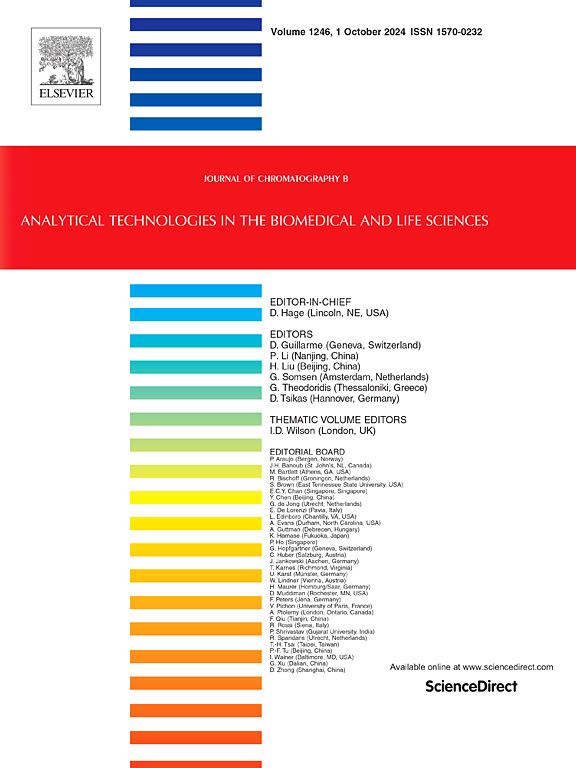四极气相色谱-负离子化学电离-串联质谱法分析五氟苯三甲基硅基衍生物:命名墨菲重排
IF 2.8
3区 医学
Q2 BIOCHEMICAL RESEARCH METHODS
引用次数: 0
摘要
二十碳四烯酸(花生四烯酸)是类二十碳烷酸的前体,类二十碳烷酸包括前列腺素(pg)、白三烯(lt)和内源性大麻素(ec)。基于GC-MS /MS的方法是生物样品中类二十烷醇定量分析的金标准。生物二十烷类化合物经提取和衍生化后,在四极柱气相色谱-质谱联用仪上分析为五氟苯(PFB)酯三甲基硅基(TMS)醚衍生物,即PFB-TMS。负离子化学电离(NICI)在离子源中由于[M-PFB]−产生了丰富的阴离子。碰撞电池中[M-PFB]−的碰撞诱导解离(CID)产生产物离子,这些产物离子适合在选择反应监测(SRM)模式下进行特定的定量分析。本文综述了PGs和LTs的PFB-TMS衍生物的CID气相反应。Robert C. Murphy首次报道了由氢化和脱硫的LTE4和饱和的LTB4制成的5-羟基二碳酸(HEA)的PFB-TMS衍生物,通过CID负电荷驱动TMS基团从醚基(OTMS)到羧酸阴离子[M-PFB]−的分子内重排,形成- cooo -TMS酯。我们建议将这种特殊的CID气相反应命名为墨菲重排,以纪念R.C.墨菲。经墨菲重排,HEA的PFB-TMS衍生物的前体离子m/z 399生成产物离子m/z 253和m/z 89,中性损失为146 Da。我们建议将观察到的20烷类化合物8-isoPGF2α、其2,3-二氢代谢物和2,3-二氢代谢物、F和E前列腺素的主要尿代谢物(MUM)分别命名为PGF-MUM和PGE-MUM,以及乙酰水杨酸(阿司匹林)的PFB酯的m/z 179 [m - PFB]−的CID命名为phy型重排。墨菲重排和墨菲型重排在重排和随后的中性损失和碎片方面有所不同。PGF-MUM和PGE-MUM的墨菲型重排包括由于1-或ω- coo -阴离子对ω-或1- coo - pfb酯的分子内攻击而导致的198 Da PFBOH的特异性中性损失。通过在NICI模式下对[1,1- 18o2]-和[1,ω-18O2]-二十烷酸盐的PFB-TMS衍生物进行CID研究,可以最好地识别墨菲重排和墨菲型重排。TMS18OH (92 Da)和PFB18OH (200 Da)(在二羧基二十烷类化合物中)的中性损失,以及m/z 91 [TMS18O] -的产物离子的形成将表明墨菲重排和墨菲型重排。乙酰水杨酸PFB酯的m/z 179 [m - PFB]−的CID与m/z 59(乙酸)形成产物离子将指示墨菲型重排。本文章由计算机程序翻译,如有差异,请以英文原文为准。
Analysis of eicosanoids by quadrupole gas chromatography-negative ion chemical ionization-tandem mass spectrometry as pentafluorobenzyl trimethylsilyl derivatives: Naming the Murphy rearrangement
Eicosatetraenoic acid (arachidonic acid) is the precursor of the eicosanoids, which include the prostaglandins (PGs), the leukotrienes (LTs), and the endocannabinoids (ECs). Methods based on GC–MS/MS are the Gold Standard for the quantitative analysis of eicosanoids in biological samples. After extraction and derivatization, biological eicosanoids are analyzed on quadrupole GC–MS/MS apparatus as pentafluorobenzyl (PFB) ester trimethylsilyl (TMS) ether derivatives, i.e., PFB-TMS. Negative-ion chemical ionization (NICI) generates in the ion-source abundant anions due to [M–PFB]−. Collision-induced dissociation (CID) of [M–PFB]− in the collision cell generates product ions, which are suitable candidates for specific quantitative analyses in the selected-reaction monitoring (SRM) mode. In this article, we review CID gas-phase reactions of PFB-TMS derivatives of PGs and LTs. The specific CID negative charge-driven intramolecular rearrangement of TMS groups from ether moieties (OTMS) to carboxylate anions [M–PFB]− of PFB-TMS derivatives to form a –COO-TMS ester has been reported for the first time by Robert C. Murphy on PFB-TMS derivatives of 5-hydroxy-eicosanoic acid (HEA) from hydrogenated and desulfurized LTE4, and saturated LTB4. We propose to name this specific CID gas-phase reaction the Murphy Rearrangement in honour of R.C. Murphy. The Murphy Rearrangement generates the product ions m/z 253 and m/z 89 from the precursor ion m/z 399 of the PFB-TMS derivative of HEA and neutral loss of 146 Da. We propose to name Murphy-type Rearrangements that were observed for the eicosanoids 8-isoPGF2α, its 2,3-dinor- and 2,3-dinor-5,6-dihydro-metabolites, the major urinary metabolites (MUM) of F and E prostaglandins, i.e., PGF-MUM and PGE-MUM, respectively, as well as for the CID of m/z 179 [M–PFB]− of the PFB ester of the drug acetylsalicylic acid (aspirin). The Murphy Rearrangement and Murphy-type Rearrangements differ with respect to the rearrangement ion and the subsequent neutral losses and fragmentations. The Murphy-type Rearrangements of PGF-MUM and PGE-MUM includes a specific neutral loss of 198 Da PFBOH due to intramolecular attack of 1- or ω-COO− anions to ω- or 1-COO-PFB esters. Murphy Rearrangements and Murphy-type Rearrangements are best identified by performing CID studies on PFB-TMS derivatives of [1,1-18O2]- and [1,ω-18O2]-eicosanoids in the NICI mode. Neutral loss of TMS18OH (92 Da) and PFB18OH (200 Da) (in dicarboxy-eicosanoids), and formation of a product ion with m/z 91 [TMS18O]− will indicate Murphy Rearrangements and Murphy-type Rearrangements. Formation of a product ion with m/z 59 (acetate) from the CID of m/z 179 [M–PFB]− of the PFB ester of acetylsalicylic acid will be indicative of a Murphy-type Rearrangement.
求助全文
通过发布文献求助,成功后即可免费获取论文全文。
去求助
来源期刊

Journal of Chromatography B
医学-分析化学
CiteScore
5.60
自引率
3.30%
发文量
306
审稿时长
44 days
期刊介绍:
The Journal of Chromatography B publishes papers on developments in separation science relevant to biology and biomedical research including both fundamental advances and applications. Analytical techniques which may be considered include the various facets of chromatography, electrophoresis and related methods, affinity and immunoaffinity-based methodologies, hyphenated and other multi-dimensional techniques, and microanalytical approaches. The journal also considers articles reporting developments in sample preparation, detection techniques including mass spectrometry, and data handling and analysis.
Developments related to preparative separations for the isolation and purification of components of biological systems may be published, including chromatographic and electrophoretic methods, affinity separations, field flow fractionation and other preparative approaches.
Applications to the analysis of biological systems and samples will be considered when the analytical science contains a significant element of novelty, e.g. a new approach to the separation of a compound, novel combination of analytical techniques, or significantly improved analytical performance.
 求助内容:
求助内容: 应助结果提醒方式:
应助结果提醒方式:


